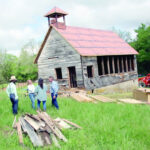Cassville awards bid to begin water line inventory
The city of Cassville has awarded a contract to begin a pipe inventory, aiming to identify and replace any lead pipes within the city.
The inventory project — which involves teamwork on federal, state and local levels — has been awarded to All Clear Pumping and Sewer, based in Centertown.
It is the initial stage of a plan to replace all lead service lines and connections that deliver drinking water to homes and businesses in communities across the nation.
According to Cassville Public Works director, David Brock, the survey, which will likely involve some excavation to uncover water mains and the service lines connecting them to meters, will be paid for with $200,000 of American Rescue Plan Act (ARPA) funds. Brock said there will be some additional costs, about $8,000$10,000, that won’t fall under the ARPA’s umbrella and will be at the city’s expense.
Getting the lead out has been an ongoing national initiative since 1978, the year lead-based paint was outlawed for use in residential and public structures. A phase-out of the use of lead in fuels followed in the 1990s.
Lead is a neurotoxin that poses a significant danger to humans, especially for young children and developing fetus- es. According to the EPA, there is no safe level of lead for drinking water. The metal, in widespread and popular use for paints, fuels, plumbing and industrial applications prior to 1978, is now known to cause impaired cognitive function, including lower IQ scores and behavioral changes, including reduced attention spans.
The toxic metal, the EPA said, can be harmful to human health, even at low exposure levels, and can bioaccumulate in the body over time.
“Young children, infants, and fetuses are particularly vulnerable to lead because the physical and behavioral effects of lead occur at lower exposure levels in children than in adults,” an EPA fact sheet said. “A dose of lead that would have little effect on an adult can have a significant effect on a child. In children, low levels of exposure have been linked to damage to the central and peripheral nervous system, learning disabilities, shorter stature, impaired hearing, and impaired formation and function of blood cells.”
This year, as part of President Biden’s Bipartisan Infrastructure Law, lead pipes and fittings in residential and public water systems across the U.S. are the subject of scrutiny.
Lead in public drinking water came to the forefront of national attention in 2014 after a change in Flint, Michigan’s water supply led to the disturbance of lead in old pipes, freeing it to contaminate drinking water and expose some 6,000-12,000 children to its adverse effects.
While Cassville and surrounding communities are not facing a scenario as dire as Flint’s, the recent federal legislation does call for the replacement of lead pipes and fitting in rural communities across the nation, including Cassville’s.
“Cassville has a total of 1,600 public water hookups,” Brock said.
All Clear Pumping and Sewer’s bid will survey 500 hookups by October, Brocks said.
“The city’s responsibility will be in the public right-of-way, where we’ll dig down to expose public connections up to residents’ water meters,” Brock said. “We’ll replace the public connections, if necessary, but water lines leading from the meter to private residences, as well as interior plumbing, will be the property owners’ responsibility.”
Brock said post cards will be mailed to homes and businesses which appear to have lead pipes or fittings so they can make an informed decision from that point.
According to Monett Utilities Superintendent, Skip Schaller, who commented in a Murray Bishoff article in The Monett Times, the standard practice for installing water systems up until the mid-1960s was to lay galvanized steel water mains and generally run galvanized steel pipes between the main and the customer meters. However, in connecting the mains to the service lines, contractors generally used easily bendable lead gooseneck pipes, Schaller said.
According to Schaller, those lead connections are still in the ground.
The new lead and copper rule calls for removal not only of the lead pipes, but also the galvanized steel pipes connected to them, into which the lead has leached.
EPA’s rule calls for cities to replace 10 percent of the lead and contaminated pipes in their town per year so all lead-based risks are remedied in 10 years.
Brock said he hopes to have the work underway by May, after a contract for a GIS (Geographic Information Systems) consultant is awarded. The consultant, Brock said, will be responsible for data collection and organization from the sites surveyed.
“We’ll start with the low-hanging fruit first, the connections that are easiest to get to,” Brock said.
Brock said homes constructed after 1986 should not have lead plumbing and will likely not be included in the survey.




